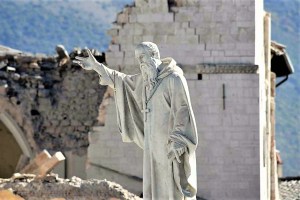We support our Publishers and Content Creators. You can view this story on their website by CLICKING HERE.
Daniel McInerny’s “Beauty and Imitation” seeks to retrieve, with the philosophical aid principally of Aristotle and St. Thomas Aquinas, the pre-modern understanding of art as imitation of the beautiful forms that make up sacred order.
Beauty and Imitation: A Philosophical Reflections on the Arts, by Daniel McInerny (448 pages, Word on Fire Academic, 2024)
Once upon a time, art was the handmaid of religion.
Culture was understood as society’s “address to sacred order,” and art was at the very heart of that “address.”
The cave drawings of Lascaux and Peche Merle, the tragedies of Aeschylus and Sophocles, the architecture of the Parthenon, Michelangelo’s Sistine Chapel ceiling, and Palestrina’s polyphony—each of these works was the product of a believing community giving praise to the divine and seeking to understand itself as existing under sacred order.
Art as address to sacred order saw itself, to borrow a term from J.R.R. Tolkien, as sub-creation. It was human making done from materials provided by sacred order, for the sake of contemplating and celebrating that order, under the aspect of its beauty.
Such work was driven by an understanding of art as mimēsis. This Greek word is often translated as “imitation” or “re-presentation.” Art as mimesis re-presents, makes present again, the sensible and intelligible forms of things in media other than their own, for the sensible and intelligible delight of an audience.
When we take in Hans Holbein the Younger’s portrait of Sir Thomas More, Thomas More is truly present in the portrait. Not, of course, in all his living three-dimensionality. But the sensible look of his features, and of his bearing, are right there, amazingly, on Holbein’s two-dimensional canvas, as are, even more amazingly, certain signs of the character of the man who would not sacrifice God’s law to the whims of a human prince.
But then one day, something happened to culture and to art.
Culture no longer saw itself as the address to sacred order. Indeed, culture began to style itself as emancipation from that order.
It is a long story, the story of modernity. Suffice to say here that the arts, having lost their home in culture’s address to sacred order, became homeless. No longer were they integrated into religious ritual and practice, or even a religious understanding of reality. Like refugee children, they were sent into the world to whomever would give them asylum: curators of museums and galleries, managers of concert halls, connoisseurs with private collections. The Church and believing patrons of the arts were eventually superseded by the secular marketplace. Art disintegrated along with believing communities, leaving elite tastes in art separated from the popular taste for entertainment.
Art itself changed character. The more emancipation took the place of the sacred, the more art itself, as the voice of emancipation, became “sacred,” and the genius-artist the “priest” of the age.
What the genius-artist was able to do that we normal folk could not was express his most authentic self. The genius-artist did not sub-create; he created something free and original out of that collection of passions and preferences that made him, at least for a time, who he was.
So, we come to our own chapter in the decline and fall of culture and art: the chapter in which, both in art and in life, just about anything goes.
For which passions and preferences are the important ones? Which artists are culturally valuable? Which do we most need to help us understand our lives as human beings? Such questions can only be answered now by individuals seeking art that resonates with their own sense of authenticity. As long as someone takes the artist’s expression to be meaningful—even if only the artist himself—then the work is as valuable as any other.
Today, Word on Fire Academic releases my book Beauty & Imitation: A Philosophical Reflection on the Arts. I am very pleased and deeply honored to publish a book with the academic imprint of a ministry I have come to admire so much.
My book does not recount the cultural history of which I have only given a thumbnail here. Instead, it seeks to retrieve, with the philosophical aid principally of Aristotle and St. Thomas Aquinas, the pre-modern understanding of art as imitation of the beautiful forms that make up sacred order. It is precisely because we are so inured to the modern conception of art as expressive authenticity, and often so blind to the absurdities to which it reduces itself, that we require a focused reflection on what art might be on a completely different, more coherent understanding.
Among the questions Beauty & Imitation pursues are the following:
- If art is imitation, does that mean that art is merely a copying of nature? How much room does mimesis make for creative liberties? Is all modern art suspect?
- Aristotle speaks of poetry as the imitation of “men in action.” Does this mean that poetry imitates the actions human beings take as they quest for happiness? If so, could such an understanding apply to arts other than poetry? Could even music be considered an imitation of “men in action”?
- What is it that makes a work of art beautiful? Does a beautiful work of art imitate Transcendent Beauty? If not, then what does it imitate?
- Is beauty the same in every kind of art? Or is beauty, rather, an analogous concept that is realized in different ways in different kinds of work?
But my discussion of mimetic art does not take place exclusively on this high level of philosophical abstraction. For one thing, I hazard in one chapter a foray into theology in order to take up the nature of the specifically Catholic imagination. Moreover, in an interlude, I offer a seriously playful dialogue that riffs on Tolkien’s short story “Leaf by Niggle.” And then, just about half the book consists in a “guided tour” of various mimetic arts. On this tour, I consider in detail the arts of music, poetry, painting, cinema, acting, and the novel, along the way considering works by artists such as Bach and Billie Eilish, Gerard Manley Hopkins and Shakespeare, Caravaggio and Cézanne, Christopher Nolan and Greta Gerwig, and Anthony Hopkins and proponents of Method Acting.
Beauty & Imitation brings to bear scholarly philosophical resources on important questions about the nature of art. But it was not written just for those with a degree. The book’s narrative approach is meant to keep art’s most burning questions from getting lost in the fog of academic debate.
It would be most satisfying for me, in fact, if those who simply have a deep love for art, and not least artists themselves, found some illumination in the book, and an important resource for their own efforts to recall the arts to their proper function in humanity’s address to sacred order.
Bibliographical Note: For more on culture and art as the address to sacred order, see Philip Rieff, My Life Among the Deathworks (Charlottesville, VA: University of Virginia Press, 2006). For more on the transformation of art in the modern world, see Larry Shiner, The Invention of Art (Chicago, IL: University of Chicago Press, 2001), and Charles Taylor, Sources of the Self (Cambridge, MA: Harvard University Press, 1989).
Republished with gracious permission of the author from Word On Fire.
The Imaginative Conservative applies the principle of appreciation to the discussion of culture and politics—we approach dialogue with magnanimity rather than with mere civility. Will you help us remain a refreshing oasis in the increasingly contentious arena of modern discourse? Please consider donating now.
The featured image, uploaded by Michael Barera, is a photograph of the Layton Art Gallery in the European Galleries at the Milwaukee Art Museum in Milwaukee, Wisconsin (United States). This file is licensed under the Creative Commons Attribution-Share Alike 4.0 International license, courtesy of Wikimedia Commons.

 Conservative
Conservative  Search
Search Trending
Trending Current News
Current News 






